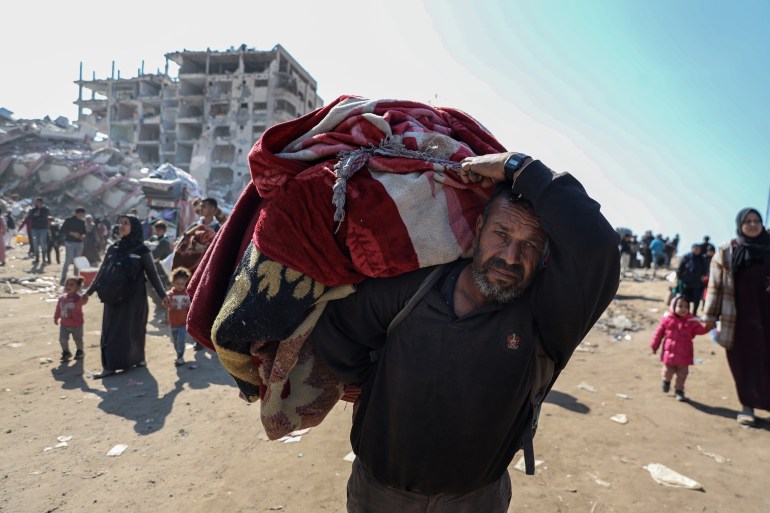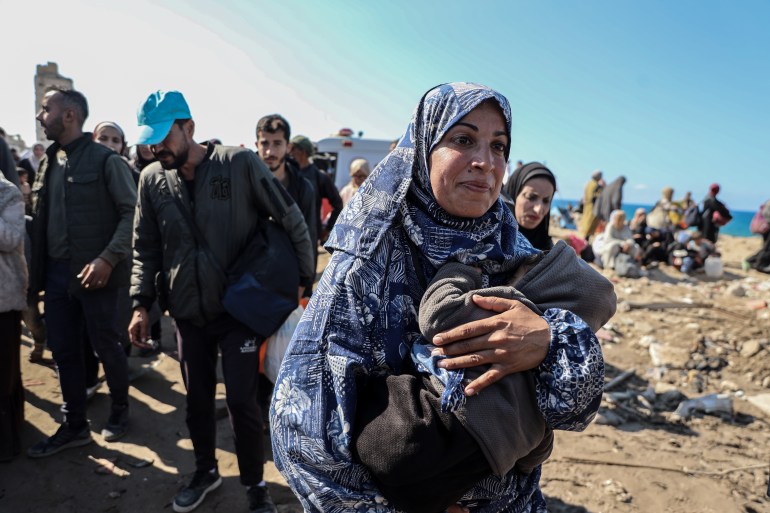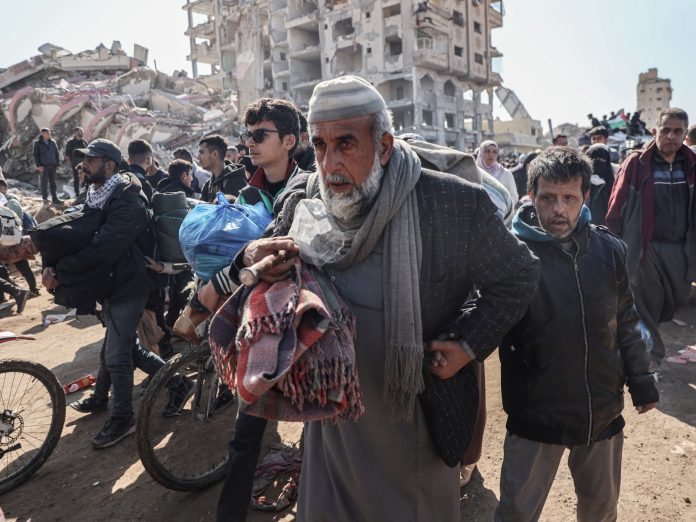Al-Rashid Street, Gaza City, Palestine – Many stories emerge from the crowds of people walking along Gaza’s al-Rashid Street, moving towards the north.
Among them is a man with a white beard, marching resolutely with his family. In one hand, he holds a blanket and a few meager belongings, while the other supports his adult son with Down Syndrome.
Rifaat Jouda acknowledges his fatigue as he embarked on his journey from southern Gaza, specifically al-Mawasi in Khan Younis, where his family had been displaced for 15 months during Israel’s war on Gaza.
The goal was to reach Gaza City, made possible after Israel granted permission for Palestinians in the southern Gaza Strip to travel north following a ceasefire on January 19.
However, the journey is quite long – approximately 30 kilometers (18.6 miles) along the coastal road. Rifaat’s family had to take breaks every hour due to exhaustion.
“The journey has been challenging and exhausting,” shares Rifaat upon finally reaching Gaza City. “Nevertheless, we were determined to return.”
Now back home, Rifaat is uncertain about his next steps. His physical residence in northern Gaza City no longer stands, destroyed in an Israeli attack in October.
“They say the situation is dire in Gaza City, lacking water, services, and marked by widespread destruction,” Rifaat describes. “But what choice do we have? We are transitioning from a difficult situation to an even more challenging one. We will rebuild what we can. Nonetheless, the act of returning has uplifted our spirits and reignited our hope.”
Regretting displacement
Prior to the war that commenced 15 months ago, the bulk of Gaza’s population resided in the north, centered around Gaza City, the enclave’s largest urban area. Nonetheless, this region bore the brunt of Israel’s attacks, prompting forced evacuation directives early in the conflict, urging civilians to seek refuge in “safe zones” in central and southern Gaza.
Consequently, a majority of Gaza’s approximately 2.3 million populace found themselves displaced to these central and southern regions, beneath a corridor referred to as Netzarim by Israel.
Despite the extensive damage in the north – about 74 percent of buildings in Gaza City were impacted by the war – the designated safe zones did not escape destruction. The areas where people sought shelter were also ravaged, with 50 percent of buildings damaged or destroyed in Deir el-Balah in central Gaza, 55 percent in Khan Younis in southern Gaza, and 48 percent in Rafah in southern Gaza.
The relentless Israeli assaults, resulting in a minimum of 47,300 casualties during the war, coerced Palestinians to constantly change locations, leaving many regretting the decision to abandon Gaza City and the north initially.
“The period of displacement was intertwined with immense difficulty and exhaustion,” states Rifaat. “It’s inconceivable to envision continuing our lives as displaced individuals away from our homes.”
Rifaat further suggests a potential return to Ashdod, a city just north of Gaza now in Israel, from which his family was evicted in 1948 during the Nakba, or “catastrophe,” marking the establishment of Israel.
Displacement remains a prevalent theme for Palestinians, tracing back to the 1948 Nakba, when over 750,000 Palestinians were uprooted from their residences. Many individuals in Gaza are descendants of refugees, originally hailing from areas now part of Israel. Consequently, especially following the recent experience during the Gaza war, numerous regret forsaking their northern homes.
Sami al-Dabbagh, a 39-year-old en route to Sheikh Radwan in northern Gaza, recounts being displaced to various locations before settling in central Gaza. After enduring hours of walking, the father-of-four vows never to repeat the same mistake.
“We refuse to undergo another displacement, regardless of circumstances,” asserts al-Dabbagh.
His sentiments echo those of Radwan al-Ajoul, a man returning to northern Gaza who affirms, “Displacement has taught us the importance of staying in our homes.” Carrying his possessions on his shoulder, the 45-year-old father of eight expresses joy at the prospect of returning.

Returning without family members
Conversations along al-Rashid Street are brief, as people have been in motion for hours, attempting to locate their loved ones, aiding the infirm, and carrying whatever possessions survived over a year of conflict and displacement.
These exchanges unveil the profound losses endured by Palestinians in Gaza.
Khaled Ibrahim, aged 52, hails from Khan Younis and is bound for Beit Lahiya north of Gaza City. With no home left for his family of four, he plans to erect a tent as shelter.
However, beyond a physical abode, Ibrahim mourns the loss of his closest kin; his wife, granddaughter, and two brothers perished in a bombing near their tent in Khan Younis last June.
“Our existence is filled with hardship. We have been stripped of everything,” laments Ibrahim.
Another returnee, Nada Jahjouh, has also endured familial tragedy. One of her sons fell victim to an Israeli assault during Gaza’s Great March of Return in 2018, prior to the recent conflict. Another son lost his life in May amid an Israeli attack, leaving Jahjouh with only one son and a grandson whom she carries on her journey.
“We are drained, both physically and emotionally,” Jahjouh reflects. “Returning without my sons evokes profound sadness. My joy remains incomplete.”





